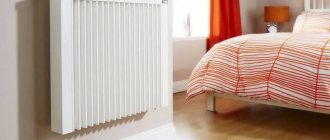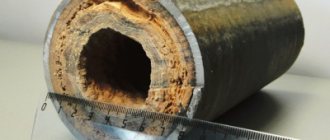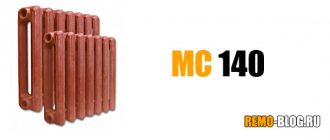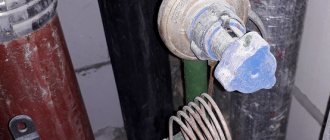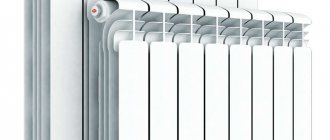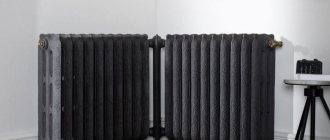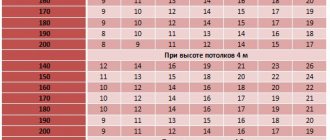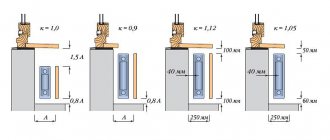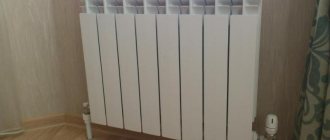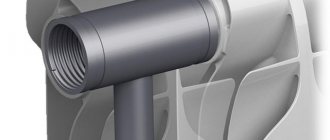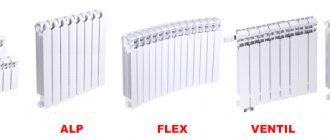The best premium aluminum radiators
The high price of these batteries is justified by the excellent build quality and materials. They are manufactured by trusted manufacturers and have a long service life.
Royal Thermo Revolution 500
4.9
★★★★★ editorial assessment
94% of buyers recommend this product
Aluminum radiators from Royal Thermo have a unique design with wave-shaped sections and additional side fins on the manifold. This ensures increased heat transfer and effective natural air convection.
The batteries are made of an aluminum alloy with a high content of titanium and silicon, which protects the material from corrosion.
The design uses anti-corrosion nano-polymer membranes on plugs, ensuring tightness. The radiators underwent two-stage painting.
Advantages:
- High-tech design;
- Additional ribs;
- Wave-shaped sections;
- Polymer membrane;
- Two-stage staining.
Flaws:
No thermostat.
Royal Thermo Revolution 500 radiators can withstand high pressure in the system and are able to work with water and antifreeze.
Stout Bravo 500
4.9
★★★★★ editorial assessment
91% of buyers recommend this product
High-quality aluminum radiators are made by casting. They consist of sections, which are a solid monolith of two collectors and fins connecting them. Inside the structure there is a vertical channel with an oval cross-section.
This design ensures low hydraulic resistance and high heat transfer rates. Radiators quickly heat up any room.
The equipment has high-quality nipple connections that ensure complete tightness.
The units are suitable for connection to heating systems with water and antifreeze. The surface is painted with durable powder enamel, not subject to fading and corrosion.
Advantages:
- Unique design;
- High heat dissipation;
- Maximum tightness;
- Resistant enamel;
- Quick installation.
Flaws:
There is no built-in thermostat.
High-quality radiators Stout Bravo 500 can be connected to centralized and individual heating.
Halsen 500/96
4.8
★★★★★ editorial assessment
88% of buyers recommend this product
Radiators from Halsen have an enlarged collector, which allows fluid with sand and mechanical inclusions to pass through without problems. They also received enhanced internal corrosion protection.
The units are capable of working with aggressive liquids used in heating systems that can withstand sub-zero temperatures. The surface is painted with high quality white enamel.
Advantages:
- Enlarged manifold;
- Increased corrosion protection;
- Resistance to aggressive liquids;
- High-quality coloring;
- Versatility of use.
Flaws:
For side connection only.
Radiators HALSEN 500/96 are suitable for any premises, including industrial and office spaces.
Global VOX-R 500
4.6
★★★★★ editorial assessment
83% of buyers recommend this product
Sectional radiators with a center distance of 500 mm from Global will be an effective solution for heating residential and non-residential premises. They are suitable for operation in autonomous and centralized heating systems and are characterized by high heat transfer. The batteries can work with water and antifreeze.
The radiator sections are connected to each other by nipples. To ensure complete tightness of the structure, special seals are used.
As standard, radiators are painted white; other options are available upon individual order.
Painting is carried out on all sides of the sections, including the sides, which provides an excellent appearance and protects the metal from corrosion.
Advantages:
- Reliable connections via nipple;
- Sealing gaskets;
- Possibility of color painting;
- High heat dissipation;
- Suitable for systems with antifreeze.
Flaws:
They do not tolerate pressure changes in the system well.
Aluminum radiators VOX-R 500 from Global are used in individual heating systems with any pipes: copper, steel or metal-plastic.
Design and external differences
Before going to the store, we recommend that you familiarize yourself with the characteristics of the models, and then it will be easier for you to decide whether it is better to install cast iron or bimetallic heating radiators in your home:
| Cast iron |
|
| Bimetal |
|
The photo shows sections of a bimetallic heating device in section
Heat transfer indicators
First cast iron:
- It heats up very slowly, but if the heating is turned off, it is able to maintain its temperature for a long time.
- Such radiators heat the air in two ways:
- convection;
- radial.
This means that during their operation, not only the air, but also nearby objects are heated.
- The thermal power of the radiator is always indicated for one section and, depending on the model, can vary from 100 W to 160 W.
Cast iron takes a long time to heat up, but is able to accumulate heat
Now bimetallic models:
- Unlike cast iron, they heat up almost instantly, but also cool down instantly.
- The devices emit much less radiation energy, so they are practically unable to heat nearby objects.
- Most of the heat in the room comes through convection.
- Their thermal power also depends on the type of model and can range from 150 W to 180 W in each section.
- Their only advantage, compared to traditional cast iron, is the speed of heating.
If you need to quickly heat the room, the choice is a bimetal heating device
So, in this case, it is difficult to say whether bimetallic or cast iron radiators are better. It all depends on how often your home heating fails.
Pressure indicators
In apartments of multi-storey buildings, devices must be installed that can withstand not only high pressure, but also pressure changes. Otherwise, when the supply of hot water suddenly stops, the batteries may receive a water hammer, as a result of which they may burst with all the ensuing consequences.
Therefore, when choosing a cast iron or bimetallic radiator, consider the following:
- The maximum pressure that cast iron can withstand is 9-12 bar, which is not very much. And if the above situation occurs, the battery may burst.
- Bimetallic radiators are not afraid of any water hammer, since their technical parameters are higher, which allows them to withstand pressure of 20-50 bar.
Design of a cast iron radiator section
Coolant resistance
High pressure and its drops are not the only problem with centralized heating systems. Another problem is the low quality of the coolant. In addition to containing various chemical compounds, tiny particles of sand and pebbles enter the batteries along with water.
So which radiator is better, bimetallic or cast iron in this case?
Consider below:
- Cast iron does not enter into a chemical reaction , so the presence of any chemical compounds does not threaten it. It does not corrode even in summer, when water is drained from pipelines. However, small pebbles can make the metal thinner over time, but if the walls of the battery are thick enough, the device is not afraid of small particles.
- Resistant to chemicals and bimetal . But its problem is that when water is drained from the pipeline in the summer, air remains in the radiators, which can harm the steel core.
Advice: if you periodically drain water from your heating system, it is better to opt for cast iron batteries, in this case they are much more durable.
Extreme heat and temperature changes
In urban heating systems, instability is observed not only in pressure, but also in the temperature of the supplied coolant.
And here you should know what to expect from both types of radiators, and whether they can withstand too much heat:
- The highest temperature that a cast iron radiator can withstand is 110 °C.
- For a bimetallic heating device, this figure is slightly higher and amounts to 130 °C.
However, they are both able to tolerate temperature changes painlessly, so there are no losers here. It should be noted that steel and aluminum have different expansion. Because of this, in the event of a sudden change in temperature, the bimetallic radiator may crackle.
Replacing cast iron radiators with bimetallic ones in a multi-storey building should be carried out by specialists
Tip: a bimetallic device can be used in autonomous heating systems.
Life time
If you maintain a cast iron battery in proper condition during operation - periodically wash it - it can survive the change of several generations. It is not for nothing that many old houses have preserved some equally ancient specimens.
As for a bimetal radiator, the instructions give sectional models about 15-20 years. Monolithic specimens are capable of outliving their counterparts by another 5 years. Therefore, here modern bimetallic batteries are significantly inferior.
Installation: which is easier?
To understand this, you just need to take both radiators in your hands one by one.
Of course, much more problems will arise with the installation of a cast iron product:
- It is very difficult for one person to lift a full-size battery;
- it must be mounted on special brackets capable of withstanding such a load, and on a main wall.
You can install a bimetallic heating device in a private house yourself
For example, even a plasterboard partition can withstand the weight of a bimetallic radiator.
Design features and types of steel heating radiators
The high manufacturability of steel does not require proof. This ductile, durable, flexible and malleable material lends itself well to welding and also conducts heat remarkably well. So steel is suitable for radiators in many ways.
Steel radiators are available in two types:
- panel;
- tubular.
Panel type radiators
In the middle of this device there are one, two or three panels. Each of them consists of two flat steel profiles, welded along the contour for connection. The plates are stamped, after which oval vertical channels are formed on them - paths for the coolant. The production of these radiators is simple - roller welding connects stamped blanks. After this, the finished parts are fastened together in two pieces using pipes.
Construction of a steel convector radiator.
To increase heat transfer, manufacturers often equip panels on the inside with U-shaped ribs. For their manufacture, thinner sheets of steel are taken than for panels. The fins help increase convection. If several panels are connected in a row, then they are covered with casings on both sides. Depending on the number of heating and convector panels located inside the radiators, there are the following types.
Type 10 is a single-row radiator without a convector and without lining.
Type 11 is a single-row radiator with one convector, without an upper grille.
Type 20 is a two-row radiator without a convector, with an air outlet grille.
Type 21 is a double-row radiator with one convector fin, covered with a casing.
Type 22 is a double-row radiator with two convector fins, covered with a casing.
Type 30 - three-row, without convector fins, covered with a grille on top.
Type 33 is a three-row radiator with three convector fins, covered with a casing.
The finished radiator is quite narrow, which is very convenient for installation. The price of such products is very affordable, so owners of their own homes prefer to install them.
Tubular radiators
Steel pipes welded together form the core of this heating device. However, it also serves as a body. Making such a radiator is not as simple as the previous one, but there are undoubtedly many more variations of models. The most common classic option is a radiator similar to cast iron, but with many more channels for coolant movement.
The number of channels that a pipe radiator can have.
Such a device is quite expensive, and it cannot be called a budget option. This is more of an option for a designer who is not strapped for money.
All possible colors of pipe radiators.
His imagination, coupled with bright colors, original shapes and the entire range of sizes, makes it possible to make such radiators a real “highlight” of a stylish and beautiful interior.
Summarizing
To correctly compare cast iron and bimetallic radiators, you need to consider the following set of parameters:
- Design features and appearance;
- Heat dissipation;
- Pressure resistance;
- Demanding on the quality of the coolant;
- Maximum permissible operating temperature;
- Life time;
- Difficulty of installation;
- Price.
By understanding which batteries are better - cast iron or bimetallic, and comparing them according to these parameters, we can draw the following conclusions:
- For small multi-storey buildings, cast iron radiators are quite suitable - as a rule, buildings no more than five floors high are characterized by low pressure in the heating system. However, bimetallic products will be more reliable, although they will cost more.
- In taller buildings, where the pressure and temperature of the coolant are higher, it would be advisable to install bimetallic radiators designed for more severe operating conditions.
- Cast iron radiators can be replaced either with similar ones, only new ones, or with bimetallic ones. If steel or aluminum radiators were initially installed in the apartment, then the question of which radiators are better - cast iron or bimetallic - does not even arise - the obvious choice would be bimetallic products.
Conclusion
Comparison of cast iron and bimetallic radiators is quite justified - these devices have both similarities and differences. You need to choose the most suitable option depending on the specific operating conditions and your own financial capabilities.
Baseboard heating convectors
This type of radiator is used extremely rarely and is not popular. They are mounted on the wall, have a small height (only 20-25 cm) and depth (only 10 cm).
Advantages of baseboard convectors:
- high efficiency - 40% less fuel required for heating;
- there is protection against overheating;
- installation is carried out without any professional skills;
- high maintainability;
- There is a thermostat as standard.
Disadvantages of baseboard convectors:
- Only a specialist can install this heating system - you will need certain professional skills;
- high price;
- convectors fit too tightly to the wall - the finish will be damaged at the points of contact.
TOP 4 steel heating radiators
Steel radiators are characterized by reliability and high heat transfer. The disadvantages include instability to water hammer and susceptibility to corrosion. Some manufacturers use special coatings that protect against it. Most steel radiators are panel-type, i.e. it is impossible to assemble the required number of sections, as in aluminum and bimetallic ones. The exception is tubular steel radiators.
Axis Classic 22 500×1000
The steel radiator consists of two water-conducting panels and two convection rows. The outer grille is removable so you can clean the internal parts. It differs from the typical dimensions characteristic of all models in the rating (50×100×10 cm) by being slightly thicker - 11 cm. Almost all radiators weigh about 28 kg. The water capacity is 5.63 liters. Steel radiators differ from bimetallic radiators in lower operating pressure - 9 bar (13.5 - when crimping). ½" side connection. The center distance is non-standard – 449 mm. Designed for coolant temperatures up to 120 °C. The model has increased power – 2188 W.
Advantages:
- Nice view. Simple design.
- High quality build. Russian production on Italian equipment.
- The kit includes everything needed for installation.
- It warms well.
- Inexpensive.
Flaw
- Non-standard interaxle connection. There are no problems if the connections are made with polypropylene pipes.
Axis Classic 22 500 1000 costs 3,700 rubles. The model surpasses all types of steel radiators included in the rating in terms of power. Provides quick heating of the room. The quality of the metal and reliability satisfied demanding users, so the vast majority of them recommend the product for purchase.
Buderus Logatrend K-Profil 22 500×1000
It features a large volume of water capacity – 6.3 liters. The operating pressure in the system is higher - up to 10 bar, but the power is lower - 1826 W. According to the manufacturer’s calculations, one radiator is enough to heat a room of about 18 square meters. m. The model undergoes anti-corrosion treatment by phosphating and hot powder spraying. Center distance – 450 mm.
Advantages:
- Laconic design.
- Nice painted. Does not turn yellow over time.
- They warm well.
- Build quality is ok.
Flaw:
- One radiator is not enough for the declared area (but depends on the temperature of the coolant).
Price Buderus Logatrend K-Profil 22 500 1000 - 4270 rubles. The model is somewhat inferior to the Axis Classic 22 in terms of power, but has a higher quality anti-corrosion coating. Buyers are satisfied with the quality of workmanship and the performance of the radiator.
Kermi FKO 22 500×1000
It has the smallest volume - 5.4 liters. But it is inferior in power to the first two models - 1808 W. Designed for system pressure up to 10 bar (13 bar – pressure testing). Provides for operation at coolant temperatures up to 110 °C. Center distance - 446 mm. The manufacturer used Therm X2 technology, which increases the energy efficiency of the equipment. The outer coating is made of two layers of powder paint, which increases resistance to mechanical damage.
Advantages:
- Beautiful view.
- Made with high quality.
- Easy to care for.
- Good heat dissipation.
Flaw:
There are cases of leakage after several years of use (in an apartment building where the system is drained for the summer).
Kermi FKO 22 500 1000 for 6200 rubles provide a normal level of heat. Thanks to the small volume of coolant, heating of the radiator and room occurs faster. Recommended for installation in a closed system without draining the coolant for a long period.
Arbonia 2180 1800 270
The only representative of tubular steel radiators in the review. It differs from panel models in non-standard dimensions. This is a narrow model (65 mm) with a very high height (1800 mm). The width of one section (tube) is 45 mm. Center distance - 1730 mm. One section weighs 2.61 kg, but it includes a much larger volume than aluminum and bimetallic radiators - 1.56 liters. In terms of heat transfer, the six-section Arbonia is expectedly inferior to other models in the rating - 1730 W. Power – 990 W.
Advantages:
- Interesting view.
- Normal heat dissipation. Heats well.
- High quality build.
Flaw:
- It is necessary to take into account the installation location and the possibility of pipe connections. If there are windows in the room, they will blow (you can’t place such a radiator under them).
Arbonia price 2180 1800 270 – 9950 rubles. You can choose the number of sections, unlike other steel samples. Non-standard sizes significantly increase heat transfer due to the larger radiator area. Can become part of the interior. Buyers have no complaints about quality.
Do cast iron batteries need to be replaced during repairs?
Dismantling old plumbing and communications during a move or renovation is common. However, such a component of the house as cast iron batteries is not always replaced in such cases. The reason is the established opinion that old cast iron batteries are good and nothing can be better than them. But is this really so? What are their advantages and disadvantages, and is it worth replacing cast iron batteries with modern ones? For those who are puzzled by this issue, the Santekhbomb store has prepared useful material that will help you make the best decision.
Advantages and disadvantages of cast iron batteries
First of all, it is worth clearly defining all the pros and cons of cast iron radiators, because they, like any other types of batteries, have their own characteristics that should be taken into account before removing them (or, conversely, purchasing them).
pros
- Reliability and durability. Cast iron is unpretentious to the coolant; it will not be damaged even by large fractions or aggressive chemical impurities, often contained in water from Russian thermal power plants. The maximum permissible coolant temperature reaches 130-150 degrees. With regular cleaning, the service life of such a battery can be decades.
- High heat capacity and thermal inertia. Such batteries give off heat for a long time, which after switching off can remain in them up to one third of the original volume. However, this same feature of the material is also its disadvantage - more about this in the corresponding section.
Minuses
- Heavy weight. Cast iron is a very heavy metal; the weight of one section of a cast iron radiator can reach several kilograms. On average, this is 2-3 times more than the weight of a bimetallic battery section, and 4-6 times more than the weight of an aluminum radiator. .
- Price. One section of a cast iron radiator is noticeably more expensive than a section of a bimetallic or aluminum battery that is similar in size and heat transfer.
- Impossibility of installation in a system with automatic adjustment.
The design features of the battery and the properties of the metal will prevent the sensors from receiving up-to-date information about the temperature of the coolant and surface. When choosing which heating radiators are best to install in an apartment, be sure to take this nuance into account. - Low efficiency.
Due to thermal inertia, heating a square meter of area will require much more energy and coolant than in the case of other types of batteries. This may be completely unimportant if your heating is centralized and you pay based on the square footage of the house. But if you have a gas boiler, you will have to spend more of your own money, and it will be spent mainly on heating the battery itself, and not on increasing the temperature in the room. - Unaesthetic appearance.
Note that this only applies to old batteries, but if you have just such ones, they are unlikely to fit harmoniously into a modern environment. In this regard, cast iron batteries of the new type are no different from their bimetallic or aluminum “brothers” - they look modern and stylish and will fit perfectly into the interior of any apartment.
What are the replacement options?
So, you have decided to replace your old cast iron batteries with new ones. What is better to choose to replace them?
New cast iron batteries
If the advantages of a cast iron battery outweigh its disadvantages for you, we can recommend you high-quality modern cast iron batteries. In the Santekhbomba store you will find several practical options - the STI Nova 500 and STI Nova 300 models are presented to your attention.
They differ from each other in size and power characteristics - for example, the “senior” model 500 has a heat output of 150 W per section, the weight of the section is 4.2 kg, and the volume is 0.52 liters. For the 300 model, these figures are respectively 120 W, 2.9 kg and 0.3 l, while it is 20 cm lower.
Both radiators have an original design; a heat-resistant polymer coating is applied to the surface.
For those who prefer a familiar design, the classic MC-140 model is perfect. Consisting of 7 sections of 150 W each, it looks almost the same as “those” Soviet batteries. And, of course, it is still heavy, since it is made of real cast iron. However, you haven’t forgotten what advantages this material has, have you?
Bimetallic batteries
Should cast iron batteries be replaced with bimetallic ones? When the cast iron option is not suitable, bimetal batteries are an excellent solution. Usually this word refers to the duo of aluminum and steel (instead of which copper is sometimes used).
Aluminum plays the role of an external material, while the radiator core is made of steel, since this metal is more resistant to high temperatures and other adverse conditions. In this regard, it has similar characteristics to cast iron, because steel is not afraid of aggressive chemical environments, and it is also resistant to corrosion.
And in terms of maximum withstand pressure, steel even surpasses cast iron - the steel core allows you to reach a working pressure of up to 30-40 atmospheres, and it is not afraid of possible water hammer.
Aluminum, in most modern models, has almost no contact with the coolant, while receiving energy from steel, it quickly heats up and transfers heat to the room. Another important advantage of bimetallic batteries is the small volume of coolant.
So, bimetallic batteries:
- lungs;
- graceful;
- heat up quickly;
- serve for a long time;
- not subject to corrosion;
- withstand enormous pressure;
- are characterized by high efficiency;
- have a small volume of coolant.
Speaking about specific models, let’s mention Alecord 350 - one of the best options in terms of quality and price. The weight of one section here is only 1.1 kg, while its heat output is 136 W. Working pressure is 25 bar (withstands up to 35), coolant capacity is 0.17 liters per section. For example, the Russian-made Halsen 350 has similar characteristics.
You can also note the interesting option Royal Thermo BiLiner 500. 171 W of heat transfer per section with its weight of 2.02 kg and volume of 0.2 liters is created on the basis of innovative high-tech solutions. Literally everything speaks about this - from the unusual design of the radiator to the 25-year warranty that covers it and the huge amount of insurance coverage. Country of origin: Italy.
Which radiators are more suitable for which systems?
1. Now, having examined and compared the main characteristics of radiators, we can draw conclusions. First, let's find out which heating radiators are better - aluminum or bimetallic - for an apartment in a multi-storey building. It uses central heating.
And this means that:
- The pressure in the system can change sharply, reaching prohibitive values. Water hammer is possible.
- The temperature will also not be stable, sometimes changing greatly during the heating season and even during the day.
- The composition of the coolant is not pure. It contains chemical impurities, as well as abrasive particles. It is hardly possible to talk about a pH not exceeding 8 units.
Based on all this, you can forget about aluminum batteries. Because the central heating system will ruin them. If electrochemical corrosion does not eat away, then pressure and temperature will finish off. And the hydraulic shock will fire the final, “control shot.” Therefore, when choosing from two types of radiators (aluminum or bimetal), choose only the latter.
2. Now let’s look at the heating system installed in a private house. A well-functioning boiler produces a constant low pressure, not exceeding 1.4 - 10 atmospheres, depending on the boiler and system. There are no pressure surges, much less water hammer. The water temperature is also stable, and its purity is beyond doubt. There will be no chemical impurities in it, and the pH value can always be measured.
Therefore, in such an autonomous heating system, you can also install aluminum batteries - these devices will work perfectly. They are inexpensive, have excellent heat transfer, and their design is attractive. In stores you can pick up batteries made in Europe. It is preferable to choose models made by casting. Bimetallic batteries are also suitable for those who live in the house itself. If you have the desire and enough funds, you can install them.
Just remember that there are many fakes on the market
And if a model (no matter aluminum or bimetallic) has a suspiciously low price, then you can already be wary. To avoid getting into trouble, check that each section and the packaging (high-quality and full-color) have the manufacturer’s markings
Which batteries are better? Cast iron or bimetallic
As practice shows, not every type of radiator is able to withstand the peculiarities of our centralized heating. At the moment, cast iron and bimetallic devices are the most resistant. Only they do not corrode and withstand high pressure. Having examined the features of each product and their technical characteristics, we will still try to find out which radiators are better - bimetallic or cast iron.
Design and appearance
Bimetallic
Bimetallic products consist of two parts. They are based on a durable steel core. And the body is made of aluminum. Due to the high thermal conductivity of the metal, heat transfer to the room increases.
Most of the models produced consist of sections and have an attractive design.
Semi-bimetallic radiators are also available. Only the vertical channels are made of steel. Such a device produces a lot of heat, but is not particularly reliable or durable.
Cast iron
Cast iron radiators today have somewhat changed their appearance. They are made both in a classic style and in a more modern one. But they still consist of several sections and have large diameter channels. For greater heat transfer, each section of the device consists of 2 parallel channels.
Cast iron products come in a variety of sizes:
- length – depends on the number of sections;
- height – from 0.35 to 1.5 m;
- depth - from a few centimeters to 0.5 m.
This allows you to select the right device according to the volume of the room.
Heat dissipation
The bimetallic radiator is the leader in terms of heating speed. The devices heat up almost instantly, but, unfortunately, if there is no heat supply, they cool down just as quickly. In this case, the heating of the room occurs according to the principle of convection - heated air rises upward, and cold air fills its place. This can also be attributed to some disadvantages.
The thermal power of one bimetallic section (the amount of heat generated by the device) is 150-180 W.
Cast iron heats up much more slowly, but also takes a long time to cool down. This is especially important in case of a sudden heat outage - the batteries will remain warm for quite a long time. Heating of the room with such devices occurs mainly by the radiation method. This means that not only the air is heated, but also objects located near the radiators.
The thermal power of cast iron ranges from 100 to 160 W.
How well do the devices withstand increased pressure?
For multi-storey buildings this question is far from idle. There are often pressure drops here, and sometimes water hammers occur.
Bimetallic products are not afraid of the most sudden pressure changes. Depending on the model, they can easily withstand pressure of 20-50 atmospheres.
Cast iron batteries can withstand up to 12 atmospheres. This is enough for the normal functioning of the heating system. But in the event of a water hammer, brittle cast iron can burst.
Ability to withstand maximum temperatures and resistance to coolant quality
The water coming from the pipes into our radiators is neither pure nor chemically neutral. The coolant temperature is also unstable.
Bimetallic devices successfully cope with all the difficulties and vicissitudes during the heating season. Bimetal is resistant to chemical additives in water. However, when water is drained from the system during warm periods, the steel core may be subject to mild corrosion.
As for the temperature regime, the products can withstand temperatures up to 1300C.
Cast iron radiators can withstand coolant temperatures up to 1100C, but in general the device tolerates temperature changes well. Cast iron is not afraid of high levels of chemicals in the energy carrier. You also don’t have to worry that the device will rust after draining the water in the summer. But small particles gradually accumulate in the lower part of the radiator. Over time, this causes a decrease in coolant throughput and a decrease in heat transfer.
Service life
Bimetallic products appeared not so long ago. Therefore, it is not yet possible to estimate their actual service life. The manufacturer provides a guarantee for a period of 15-20 years.
With proper care and periodic washing, cast iron products can last 50 years or more. This has already been tested in practice. So in terms of durability, cast iron takes the lead.
Which radiator is easier to install?
Bimetallic radiators are much lighter than cast iron ones and are quite easy to install. If installed correctly, they can be installed on any surface, even a plasterboard wall.
There will be many more problems with installing a cast iron battery. It requires special brackets; the device can only be mounted on a solid wall. Due to its heavy weight, it becomes difficult to carry and install.
Which radiator is better
Comparing the characteristics of products made of bimetal and cast iron, you can see that each of them has its own pros and cons. Therefore, make your choice based on what kind of house you live in:
- In high-rise buildings, it is better to install bimetallic batteries that can withstand heavy loads of extreme temperature and pressure.
- In your own home with an individual heating system, where there are no sudden changes in temperature and pressure, you can install cast iron appliances. They will maintain heat even if you forget to supply fuel to the boiler on time.
You can watch a video about the advantages of each device and make your choice.
What you need to know about the types of bimetallic heating radiators
Aluminum is an excellent structural material, characterized by strength, lightness and high thermal conductivity. It would be ideal for the manufacture of heat exchange equipment if it were not so sensitive to the quality of the coolant. Its structure is disrupted when the coolant acidity deviates from neutral values.
Electrochemical corrosion processes that occur upon contact with shut-off valves based on copper alloys also have a destructive effect on it. In addition, aluminum cannot withstand water hammer present in centralized heating systems.
The creators of bimetallic radiators were able to eliminate these problems. The design of such products involves contact with the coolant only of steel parts, which are externally coated with a layer of aluminum fins. As a result, the corrosion rate sharply decreased and heat transfer improved.
Bimetallic and semi-bimetallic radiators
All components of bimetallic radiators are usually made of high-quality steel, followed by high-pressure fusion of aluminum. After assembling the radiator, only the steel parts of all parts are in contact with the coolant, and the aluminum fins are in contact with the room air.
Due to the special shape of the outer surface, intense heat transfer occurs, which is what is required from a good radiator.
Construction of a bimetallic heating radiator.
Sometimes the core of radiators is made of copper alloys. In this case, they can be used in systems filled with antifreeze. The cost of such products turns out to be higher.
Semi-bimetallic radiators differ in that only the vertical channels are made of two metals, while the horizontal ones remain aluminum. The result is a small gain in heat transfer power, but there are also serious disadvantages:
- the risk of alkali corrosion has increased;
- the difference in the specific thermal expansion of steel and aluminum leads to displacement of parts, which can lead to depressurization of joints;
- such a design turned out to be susceptible to destruction due to water hammer, which often occurs in centralized heating systems.
Therefore, semi-bimetallic heating devices should be purchased with great caution; it is better not to use them in apartments with a centralized heating system
Sectional and monolithic bimetallic radiators
Initially, all bimetallic radiators were sectional. They were assembled from several identical sections, tightly connected into a single unit. In some cases, the presence of joints between sections can lead to a decrease in the service life of the radiator. During operation, moisture may enter the joints, and irreversible processes begin, leading to corrosion and depressurization.
Sectional bimetallic heating radiator.
Currently, some manufacturers produce monolithic bimetallic radiators. In such radiators, a solid steel base is created, which is covered on the outside with an aluminum shell.
Monolithic bimetallic radiators have significant advantages:
- service life doubled and reached 50 years;
- it became possible to create radiators capable of withstanding internal pressure of 100 atmospheres;
- The risk of manufacturing defects has sharply decreased.
The specific thermal power of the sections remained at the same level of 100-200 W. Due to more complex production, monolithic batteries cost 10-20% more than sectional ones. They cannot be removed or added with additional elements, so manufacturers produce a wide range of models that differ in size and thermal performance.
Monolithic bimetallic heating radiator.
Resistance to pressure changes
Centralized systems that are used for heating apartment buildings are characterized by pressure instability, up to the appearance of water hammer. This is largely due to non-compliance with the rules for using circulation pumps, according to which the taps of these devices must open smoothly. Of course, sudden changes in system operation lead to changes in pressure, and batteries that are not strong enough can simply burst because of this. It is for this reason that you need to choose cast iron or bimetallic radiators that can withstand such loads.
Radiators made of cast iron can withstand pressure up to 9-12 atmospheres. The value is significant, but with strong water hammer it may not be enough - and cast iron is fragile, so the probability of battery destruction due to a sharp pressure drop is very high. Of course, the radiator is unlikely to fail completely, but even small leaks of hot coolant pose a serious problem.
In this parameter, bimetallic radiators win an unconditional victory over cast iron ones. Different models of bimetallic devices can withstand pressure ranging from 20 to 50 atmospheres, which is quite enough even to resist strong water hammer. Radiators with a monolithic steel core stand apart, capable of withstanding pressure up to 100 atmospheres - if this parameter is critical, then the answer to the question of which is better - bimetal or cast iron batteries is obvious.
Center distance
The center distance is the distance between the location of the lower and upper collectors. As a rule, the parameter is indicated in millimeters. Standard sizes are available from 200 to 800 mm. These options are usually enough to match the radiators to the wiring installed in the room.
More often on the market there are products with a distance between the cores of 500 and 350 mm. These sizes are standard for most modern new buildings. Difficulties arise when finding narrow 200mm batteries that are well suited for a small kitchen or toilet, while wide 800mm products are usually only available to order.
Choosing bimetallic heating devices - which ones are better?
When choosing a specific model, you should take into account not only the listed characteristics.
There are other criteria on which the quality and efficiency of bimetallic radiators, as well as their service life, depend:
The radiator must have a design that is capable of operating under high pressure and water hammer conditions. This factor is especially important for a centralized heating system, where it is recommended to use reinforced bimetallic heating radiators. Pay attention to the magnitude of the pressure test. The material used for the manufacture of radiators must be resistant to the aggressive environment of low-quality coolant, which is characterized by a high alkali or acid content. This is especially true for radiators installed in apartments of multi-storey buildings. Also, the radiator material must be resistant to electrochemical corrosion. The battery case must be durable, capable of withstanding varying degrees of mechanical stress. The quality of aluminum radiators can be checked by pressing the ribs with your fingers. In this case, low-quality products bend or crack. For the manufacture of internal ribbed channels, one metal should be used, and it is better if preference is given to high-quality stainless steel. The inner pipe must have a wall thickness of more than 3-3.5 mm. The quality of the gaskets used in sectional radiators is also of great importance. High-quality and elastic gaskets make the connection tight and reliable, so rubber or silicone should be used for the manufacture of these elements. To check the quality, the gasket is bent several times. It should be remembered that a hard seal may require replacement after some time. Sectional type radiators must be equipped with high-quality steel nipples so that during the process of connecting sections the threads do not wear off or damage to the internal parts of this element occurs. When choosing which bimetallic heating radiators are best, special attention is paid to the size of the sections. For high heat transfer, the section cross-section should be 8*8 cm; with smaller parameters, the efficiency of the radiator becomes significantly lower. Sometimes manufacturers reduce the cost of products by making the sections smaller. In this case, it should be understood that the thermal power of such radiators will be slightly lower. The protruding fins of a quality radiator should have a thickness of at least 1 mm. A smaller size indicates reduced strength of the upper casing of the battery and low heat transfer, since the heat exchange plates in this case are thin, therefore, their heat capacity is also underestimated. Some manufacturers are trying to save on the quality of nipples and gaskets, which also indicates the low quality of bimetallic radiators. It is not recommended to choose these products. The service life specified by the manufacturer also indicates the quality of the radiators. On average, bimetallic sectional batteries serve flawlessly for up to 30 years, while the service life of monolithic products reaches half a century. Therefore, devices with a guaranteed period of 1-2 years may be of poor quality, and a manufacturer that is unsure of its products cannot guarantee longer use
This is very important when determining which are the best manufacturers of bimetallic heating radiators.
We make a choice of heating radiators cast iron or bimetal
Which is better, bimetallic or cast iron radiators? Bimetal is better. To verify this, it is enough to carry out a comparative description of cast iron and bimetallic heating devices.
- The thermal efficiency of bimetallic radiators is four times higher than that of cast iron counterparts.
- The ability to withstand hydraulic shocks and resist aggressive coolant environments is approximately the same. But with a sharp jump in pressure in the system, up to 15 atm, the cast iron will crack, but the aluminum-steel structure will withstand without loss of performance.
- Correspondence of radiator sections. The thermal power of one “fin” of a cast iron product will be 100-160 W, compared to 150-180 W for bimetal.
Replacing cast iron radiators with bimetallic ones is a justified and expedient solution. Although the cost of the latter is slightly higher, material costs will be recouped due to high heat transfer.
When performing work, a recalculation of the heating area during alterations is carried out. In the apartment, it is prohibited to connect devices with a higher thermal power to the heating system than specified in the design documentation. So, if the room was heated by two cast iron batteries with 8 sections, when replacing it will be necessary to install two bimetal heaters with 6 fins each.
For an apartment building, aluminum-steel batteries remain the best option. Connecting bimetal to autonomous heating systems is recommended in case of forced coolant circulation.
Radiators connected to a centralized heating system sometimes have to experience very high loads. Therefore, the only materials that can withstand high pressure and not collapse from corrosion are cast iron and bimetal (steel and aluminum). The latter resemble aluminum heating devices in appearance. To choose the right equipment, it is worth considering the characteristics of both in more detail.
Aluminum heating radiators.
Aluminum batteries are light, beautiful and have a fairly high heat transfer (4 times more than cast iron batteries), that is, such a radiator heats better with the same battery size. But aluminum, like any other material, has its drawbacks. The main one is corrosion. Destruction processes occur inside such batteries. They can occur due to the presence of copper parts in the design of the heating system or poor quality of tap water.
Aluminum batteries are heating leaders
The main feature of operation is that aluminum batteries are strictly forbidden to be left for a long time with the taps closed. Due to corrosion, about 0.1 mm of material is eaten every year. From here you can easily calculate when you need to change the heating batteries - this should be done every 15 - 20 years. Another undoubted advantage of aluminum radiators is fast heating, so if necessary, the room can be heated in just 15-20 minutes.
All radiator models currently on the market differ in both appearance and performance. A lot depends on the choice. This includes ease of use, product design, and cost-effectiveness. The most important criteria for choosing batteries are reliability, durability and safety. If the question arises: “Which heating batteries heat better?” - then it will certainly be aluminum.
Options for selecting and installing a cast iron radiator
Despite all the disadvantages of cast iron radiators, they have two significant advantages. This is low cost and the ability to accumulate heat due to its large mass.
For these reasons, it is recommended to buy them in two cases. When the minimum cost of the heating system is needed (for example, an economy-class country house or rural house), or when the heating is often turned off, for example, according to a certain schedule per day. In this case, cast iron radiators will help level out temperature changes.
A cast iron radiator has the same power calculation and installation as a bimetallic one, but has several features:
- anchors and brackets are selected with great strength;
- plastic fittings and pipes are not used for cast iron radiators;
- Due to their heavy weight, cast iron radiators must be installed with an assistant.
All modern cast iron radiators are significantly different from the usual ones installed in apartments with central heating. They have a smaller wall thickness, improved heat dissipation, and may have decor on the body.
An important feature is the anti-corrosion coating applied at the factory, which does not impair heat transfer.
5 / 5 ( 17 votes)
Features of a bimetallic radiator
Bimetallic radiators are a new technology for manufacturing heating products. To know how to distinguish bimetallic radiators from aluminum ones, you need to understand their internal structure, which combines materials with different performance characteristics: aluminum and stainless steel. The bimetallic radiator successfully takes into account the positive aspects of these two metals.
What are bimetallic radiators? Structurally, these are steel pipes with aluminum sections. Such products are considered most suitable for installation in central and individual heating systems.
The sections are made of aluminum, so they have maximum efficiency and instantly transfer heat to the room. When asked how aluminum batteries differ from bimetallic ones, they always compare the price - for bimetallic ones it is much higher.
The technology for its production is complex. High-quality products are cast under high pressure. To reduce cost, manufacturers sometimes use welding, which does not greatly affect the strength of the radiator.
The main difference between bimetallic radiators and steel ones is that they are reliably protected from corrosion by an aluminum casing.
Price
There is no need to talk for long about the cost of radiators - the relationship between price and quality is direct, so in most cases it is possible to determine which battery is better - cast iron or aluminum - based on this parameter. The cheapest are simple cast iron radiators, especially domestic ones. The quality of such products is appropriate. The next most expensive are bimetallic radiators, the price of which exceeds the cost of similar cast iron products by 1.5-2 times. Cast iron radiators made by artistic casting are the most expensive - one section of such a product can cost 10 times more than a regular one.
Design features and types of bimetallic radiators
Each bimetallic heating radiator consists of steel pipes and aluminum panels. Thanks to this, heat is transferred very efficiently without being wasted. Hot water, passing through a core consisting of steel pipes, quickly heats the aluminum shell and, accordingly, the air masses in the room.
The aluminum shaped shell of this core not only looks elegant and stylish, but also helps to better distribute heat. In addition, due to the use of aluminum, the battery is very light (especially when compared with heavy cast iron counterparts). This provides additional comfort during installation. And the intricate design of the case looks great and also significantly increases heat dissipation.
The steel pipes that make up the core are very strong - they can easily withstand pressure from 20 to 40 atmospheres, and hot water temperatures - 110 and even 130 degrees Celsius.
Specific limit values for operating pressure and temperature can be found by looking at the device passport. After all, it depends on the model, and on who made this model.
Today in the store you can buy bimetallic batteries of two types:
1. Radiators that are one hundred percent bimetallic. This means that they have a steel core of tubing surrounded by an aluminum shell. They are characterized by increased strength, leakage is excluded. Such batteries are produced by Italian companies:
- Global Style;
- Royal Thermo BiLiner.
They are also made by Russian manufacturers - for example, the company Santekhprom BM.
2. Semi-bimetallic - radiators that are only half bimetallic. Only the pipes reinforcing the vertical channels are made of steel. In this case, aluminum partially comes into contact with water. These half-bimetallic radiators dissipate heat 10 percent better than the previous type. And they cost 20 percent less.
They are released:
- Russian manufacturer Rifar,
- Chinese – Gordi,
- Italian – Sira.
Experts have not yet come to a consensus, arguing which of the two types of radiators is better for centralized heating and which for individual heating. Thus, the technical characteristics of a bimetallic radiator allow it not to be afraid of “chemistry” in city water. But at increased water pressure, aluminum behaves better. The experts agreed on one thing: if you have old heating pipes in your house (they are more than 40 years old), then it is better to use bimetallic batteries.
Sectional or solid?
The bulk of such radiators are made up of a certain number of sections. That is, first each of the sections is made completely, and then they are connected with nipples. This is done in the factory, the total number of sections is even.
If necessary, a specialist is quite capable of removing an extra section or adding a missing one.
However, in addition to sectional ones, there are also solid bimetal batteries on sale. The core of steel pipes is made immediately of the required size. It is then “wrapped” in a shaped aluminum shell. Such a battery will not burst even if the pressure reaches one hundred atmospheres.
Design and operating features of bimetallic radiators
Bimetallic design involves the use of two types of metal for the radiator. Common options are copper-aluminum and aluminum-steel combinations. The second option is much cheaper, since it does not contain expensive copper.
Pure aluminum is a material that does not have sufficient strength to withstand hot coolant with the necessary reliability.
Therefore, in both versions of bimetallic radiators, aluminum is used only for the manufacture of the heat sink element. The coolant coil in them is steel or copper.
